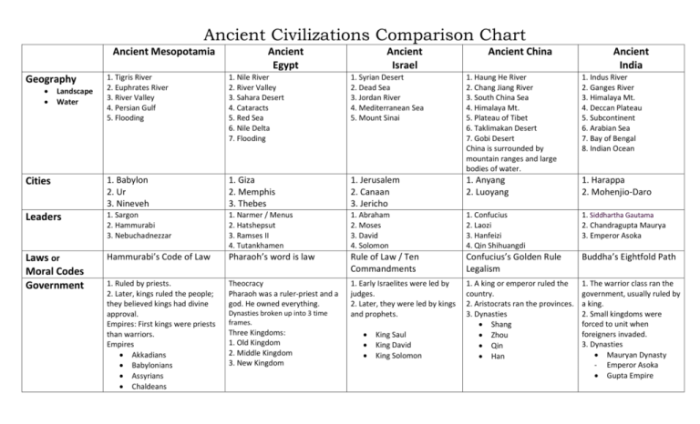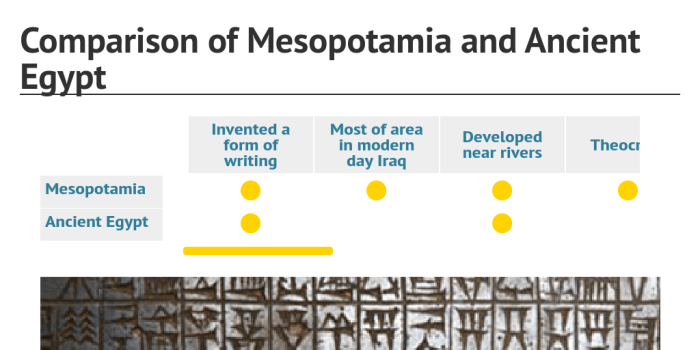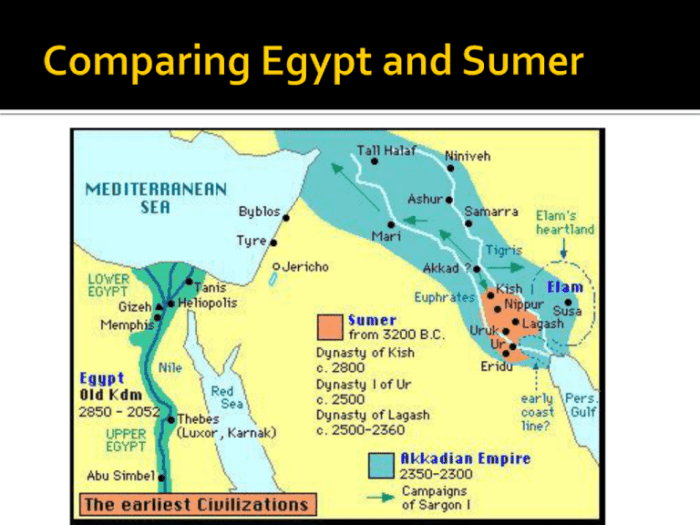In this comprehensive analysis, we present a mesopotamia and egypt comparison chart that explores the multifaceted similarities and differences between these two ancient civilizations. From their historical contexts to their artistic achievements, this comparison provides a deeper understanding of their respective contributions to human history.
Mesopotamia and Egypt Comparison Chart

Mesopotamia and Egypt are two of the oldest and most influential civilizations in human history. They both developed in river valleys, and they both made significant contributions to the development of writing, mathematics, and science.
Historical Context
Mesopotamia is located in the region of the Middle East that is now known as Iraq. The civilization of Mesopotamia began around 4000 BC, and it lasted for over 3,000 years. Egypt is located in the northeastern part of Africa.
The civilization of Egypt began around 3100 BC, and it lasted for over 3,000 years.
Political Systems
The political systems of Mesopotamia and Egypt were both based on the idea of a divine king. In Mesopotamia, the king was considered to be the representative of the gods on earth. In Egypt, the pharaoh was considered to be the son of the god Horus.
- Mesopotamia:The political system of Mesopotamia was based on a series of city-states. Each city-state was ruled by a king who was also the high priest.
- Egypt:The political system of Egypt was based on a centralized government. The pharaoh was the absolute ruler of Egypt.
Social Structures
The social structures of Mesopotamia and Egypt were both based on a hierarchy. In Mesopotamia, the upper class was composed of the king, the priests, and the wealthy landowners. The lower class was composed of the peasants, the slaves, and the artisans.
- Mesopotamia:The social structure of Mesopotamia was based on a rigid hierarchy. The upper class was composed of the king, the priests, and the wealthy landowners. The lower class was composed of the peasants, the slaves, and the artisans.
- Egypt:The social structure of Egypt was also based on a hierarchy. The upper class was composed of the pharaoh, the priests, and the wealthy landowners. The lower class was composed of the peasants, the slaves, and the artisans.
Economic Systems
The economic systems of Mesopotamia and Egypt were both based on agriculture. In Mesopotamia, the main crops were barley, wheat, and dates. In Egypt, the main crops were wheat, barley, and flax.
- Mesopotamia:The economic system of Mesopotamia was based on agriculture. The main crops were barley, wheat, and dates.
- Egypt:The economic system of Egypt was also based on agriculture. The main crops were wheat, barley, and flax.
Religion
The religions of Mesopotamia and Egypt were both polytheistic. In Mesopotamia, the main gods were Anu, Enlil, and Ea. In Egypt, the main gods were Amun-Re, Ra, and Osiris.
- Mesopotamia:The religion of Mesopotamia was polytheistic. The main gods were Anu, Enlil, and Ea.
- Egypt:The religion of Egypt was also polytheistic. The main gods were Amun-Re, Ra, and Osiris.
Technology and Innovation
The civilizations of Mesopotamia and Egypt both made significant contributions to the development of technology and innovation. In Mesopotamia, the Sumerians invented the wheel and the plow. In Egypt, the Egyptians invented the sail and the papyrus.
- Mesopotamia:The civilizations of Mesopotamia made significant contributions to the development of technology and innovation. The Sumerians invented the wheel and the plow.
- Egypt:The civilizations of Egypt also made significant contributions to the development of technology and innovation. The Egyptians invented the sail and the papyrus.
Art and Architecture, Mesopotamia and egypt comparison chart
The art and architecture of Mesopotamia and Egypt were both highly developed. In Mesopotamia, the most famous examples of art and architecture are the Ziggurats, which were massive temple towers. In Egypt, the most famous examples of art and architecture are the pyramids and the temples.
- Mesopotamia:The art and architecture of Mesopotamia were highly developed. The most famous examples of art and architecture are the Ziggurats, which were massive temple towers.
- Egypt:The art and architecture of Egypt were also highly developed. The most famous examples of art and architecture are the pyramids and the temples.
Writing Systems
The civilizations of Mesopotamia and Egypt both developed their own writing systems. In Mesopotamia, the Sumerians invented the cuneiform writing system. In Egypt, the Egyptians invented the hieroglyphic writing system.
- Mesopotamia:The civilizations of Mesopotamia developed their own writing systems. The Sumerians invented the cuneiform writing system.
- Egypt:The civilizations of Egypt also developed their own writing systems. The Egyptians invented the hieroglyphic writing system.
Mathematics and Science
The civilizations of Mesopotamia and Egypt both made significant contributions to the development of mathematics and science. In Mesopotamia, the Babylonians developed a system of mathematics that was based on the number 60. In Egypt, the Egyptians developed a system of geometry that was based on the Pythagorean theorem.
- Mesopotamia:The civilizations of Mesopotamia made significant contributions to the development of mathematics and science. The Babylonians developed a system of mathematics that was based on the number 60.
- Egypt:The civilizations of Egypt also made significant contributions to the development of mathematics and science. The Egyptians developed a system of geometry that was based on the Pythagorean theorem.
FAQ Overview
What were the key differences between the political systems of Mesopotamia and Egypt?
Mesopotamia was characterized by a decentralized system of city-states, while Egypt developed a centralized monarchy with a strong pharaoh.
How did the social structures of Mesopotamia and Egypt compare?
Both civilizations had hierarchical social structures, but Mesopotamia’s was more complex, with a larger middle class and a greater degree of social mobility.
What were the similarities and differences in the economic systems of Mesopotamia and Egypt?
Both civilizations relied on agriculture and trade, but Mesopotamia had a more developed system of irrigation and a wider range of economic activities.

